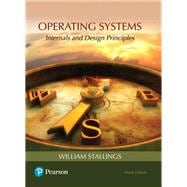For one- or two-semester undergraduate courses in operating systems for computer science, computer engineering, and electrical engineering majors
An introduction to operating systems with up-to-date and comprehensive coverage
Now in its 9th Edition, Operating Systems: Internals and Design Principles provides a comprehensive, unified introduction to operating systems topics for readers studying computer science, computer engineering, and electrical engineering. Author William Stallings emphasizes both design issues and fundamental principles in contemporary systems, while providing readers with a solid understanding of the key structures and mechanisms of operating systems. He discusses design trade-offs and the practical decisions affecting design, performance and security. The text illustrates and reinforces design concepts, tying them to real-world design choices with case studies in Linux, UNIX, Android, and Windows 10.
With an unparalleled degree of support for project integration, plus comprehensive coverage of the latest trends and developments in operating systems, including cloud computing and the Internet of Things (IoT), the text provides everything readers need to keep pace with a complex and rapidly changing field. The 9th Edition has been extensively revised and contains new material, new projects, and updated chapters.










